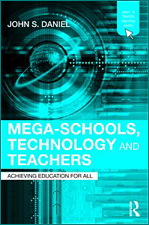Emerging Technologies in Distance Education — by George Veletsianos [via G. Siemens]
Individual chapters are as follows:
PART 1: Foundations of Emerging Technologies in Distance Education
1. A definition of emerging technologies for education | George Veletsianos
2. Theories for Learning with Emerging Technologies | Terry Anderson
3. Imagining multi-roles in Web 2.0 Distance Education | Elizabeth Wellburn & BJ Eib
4. Beyond distance and time constraints: applying social networking tools and Web 2.0 approaches in distanceeducation | Mark J. W. Lee & Catherine McLoughlin
PART 2: Learning Designs for Emerging Technologies
5. “Emerging”: A re-conceptualization of contemporary technology design and integration | The Learning Technologies Collaborative
6. Developing Personal Learning Networks for Open & Social Learning | Alec Couros
7. Creating a Culture of Community in the Online Classroom Using Artistic Pedagogical Technologies | Beth Perry & Margaret Edwards
8. Structured Dialogue Embedded within Emerging Technologies | Yiannis Laouris, Gayle Underwood, Romina Laouri, Aleco Christakis
PART 3: Social, Organizational, & Contextual Factors in Emerging Technologies Implementations
9. Personal Learning Environments | Trey Martindale & Michael Dowdy
10. Open source course management systems in distance education | Andrew Whitworth & Angela Benson
11. Implementing Wikis in higher education institutions: the case of the Open University of Israel | Hagit Meishar-Tal, Yoav Yair and Edna Tal-Elhasid
12. The Use of Web Analytics in the Design and Evaluation of Distance Education | P. Clint Rogers, Mary R. McEwen & SaraJoy Pond
13. New communication options: A renaissance in IP use | Richard Caladine, Trish Andrews, Belinda Tynan, Robyn Smyth, & Deborah Vale
PART 4: Learner-learner, Learner-Content, & Learner-Instructor Interaction & Communication with Emerging Technologies
14. Using Social Media to Create a Place that Supports Communication | Rita Kop
15. Technical, Pedagogical and Cultural Considerations for Language Learning in MUVEs / Charles Xiaoxue Wang, Brendan Calandra & Youngjoo Yi
16. Animated Pedagogical Agents and Immersive Worlds: Two Worlds Colliding / Bob Heller & Mike Procter









